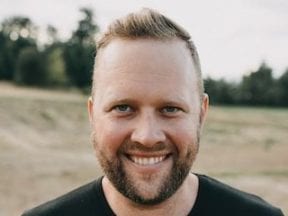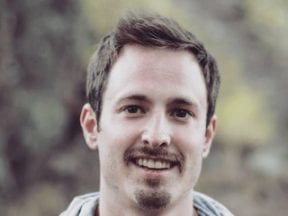Having co-founded Feat Socks in 2015, Taylor Offer hired Aly Raisman, the gymnast, to design and promote a custom sock. It generated $500,000 in revenue. Influencer marketing was clearly effective, and Offer wanted more.
“I started looking at the kids that got famous from Vine, the short-video app,” he told me.
It turned out that many of those “kids” lived in the same apartment complex on, amazingly, Vine Street in Los Angeles.
“So I flew out to L.A., snuck into that building, and I saw every single Viner that lived there. There were probably 30 kids in the building with over a million followers each. I called my co-founder in Boston. I said, ‘We’re moving to L.A. into the building on Vine Street.’ That’s how I started understanding social media and influencers.”
Fast forward to 2021, and Feat Socks is now Feat Clothing, a wildly successful brand of joggers, shorts, hoodies, and crewnecks — all made from BlanketBlend, the company’s custom fabric.
I recently spoke with Offer about the journey. Our entire audio conversation is embedded below. The transcript that follows is edited for length and clarity.
Eric Bandholz: Tell us about Feat.
Taylor Offer: We started in 2015 as a sock company. “Feat” is our spelling of “feet.” We had a heat press. We would press a design on white Nike or Adidas socks and sell them around our college campus. So, that’s how Feat started.
From 2015 to 2018, we were only making socks. We were scaling as a sock company from influencer collaborations. We were early in the influencer world, doing deals with The Chainsmokers, Logan Paul, Aly Raisman.
In 2018 we decided to expand, to make clothes that were soft and comfortable but also looked good. We wanted to combine comfort and style. And that’s how we developed our first product, called the BlanketBlend. It’s a special fabric we made. Now we have BlanketBlend joggers, shorts, hoodies, and crewnecks. It’s a soft fabric that looks and feels good.
Bandholz: I can’t imagine a better business come March 2020.
Offer: It’s was great, but we didn’t plan for the crazy spike. April was a massive month. We sold out of products in April and May. It was a huge influx of sales. It was difficult to keep up with the demand. We have manufacturers in downtown Los Angeles (for quick-turn stuff), South America, and Asia.
Bandholz: You created a fabric. How does that work?
Offer: It’s a long process. My co-founder, Parker, was much more involved in that process than I. We started with a base fabric and then made it softer. You tweak the materials a bit — a little more this material or that material. It could be polyester, cotton, or rayon. You’re experimenting with the materials. We put them through different washes. The process took a year and a half to perfect the BlanketBlend fabric.
We now own the process of making BlanketBlend and the name. Other people can try to make soft clothing. But they can’t make BlanketBlend.
Bandholz: You mentioned influencers. Can you elaborate?
Offer: We were living in Boston because we went to school there, at the University of Massachusetts. We did this deal with Aly Raisman, the Olympic gymnastics gold medalist, in 2016. We made her own custom sock. We sold around $500,000 of that sock. We thought, “This is crazy. Through Instagram, and an influencer, or an athlete, we could sell so much.”
So I started direct messaging every single person on Instagram with over one million followers. And, again, that was in 2016, before the rise of influencer marketing. A lot of those DM people responded.
Then I started looking at the kids that got famous from Vine, the short-video app, since discontinued. All their videos had the same door handle in their apartments, and the same pool, the same gym. I thought, “Either I’m crazy, or they all live in the same building.”
Finally, one of the Viners responded, “Send some socks to 1600 Vine Street, in Hollywood.” I told myself, “That’s funny. He’s a Viner, and he lives on Vine Street. Either he’s messing with me, or this is the Mecca where all these kids live.”
So I flew out to L.A., snuck into that building, and I saw every single Viner that lived there — from Logan Paul, Jake Paul, Amanda Cerny, King Bach, Lele Pons, and Rudy Mancuso. Justin Bieber was there for a while. There were probably 30 kids in the building with over a million followers each.
So I called my co-founder. We had a 2,500 square foot office and warehouse in Boston. I said, “Get out of that lease. We’re moving to L.A. into the building on Vine Street. We’re going to work with these kids and understand social media.”
And we moved into the building. That’s how I started understanding social media and influencers.
Bandholz: That’s amazing. So you would bump into them on the premises?
Offer: Exactly. It was an interesting finesse. I didn’t want to be too aggressive. I couldn’t say, “I moved across the country to be in the same apartment building as you.”
Those kids would hang out at the gym all the time. I had never gone to the gym or worked out. But I decided, “I have to be in the gym because I just have to meet those kids, get those head nods.”
So I went to the gym all day. Eventually, we crossed paths.
Then we flew Aly Raisman to L.A. for a photo shoot. It was right when she won her gold medal. We did the photo shoot in the gym when I knew all of them would be there. They were all obsessed with Aly because she just won this gold medal. She was like America’s sweetheart, gymnastics, an awesome person.
They said, like, “What’s this photo shoot?” I said to Aly, “Go tell Logan you’re selling a bunch of socks, and he can’t sell as many socks as you.” So that’s how the conversation started. I said, “Logan, dude, let’s sell some socks.”
Bandholz: Did he kill it?
Offer: Yes. It was wild. He drove over 1.5 million new visitors to our site over two weeks. That generated 20,000 new customers. We had no ads, no email capture, no email flow. We had no retargeting. There are many things I should have done better. But, yes, he crushed it.
Bandholz: You’ve transitioned away from socks.
Offer: Yes. We sell barely any socks now. Feat Socks was a lot of college humor-type stuff. We took a break from influencers for a while. We were focused on the product and experience and building an elevated brand. But we’re back, doing collaborations again. We did a great collab with Helen Owen in December. She’s a fashion influencer with 1.6 million Instagram followers. It did well. We have three or four collabs lined up for 2021.
Bandholz: How do you build the right influencer deal so it’s a win-win?
Offer: I’ve done tons of collabs. Some were extremely successful, and others were extremely unsuccessful. I’ve learned a lot. First, the person and the brand have to align. When there’s no alignment between person and brand, both sides are confused. The influencer’s followers are confused. It doesn’t convert. There has to be genuine alignment, and the influencer has to genuinely care. So that’s the first thing and the most important.
Bandholz: How do you find influencers?
Offer: We’ll gift products to them, or they’ll organically buy our products. We’ll stroll through our Shopify orders and see a prominent buyer. We’re like, “Let’s hit her up.” And she’s like, “I love your stuff.” We respond, “Let’s collab.” When it’s genuine and organic, people can tell.
Where a lot of brands go wrong is by thinking, “I’ll pay them five grand for a post.” They’ll do one post, and that’s it. It’s so far from that. It has to be a full campaign.
There are different types of collabs. You could do very small sponsor posts. You could co-brand products, which typically perform the best. A lot of these influencers want to create their own product. So I can be an enabler to create their own product and help my business, too.
You want them to feel as if it’s their product. Give them a revenue or profit share — with their own brand. Make content for them and with them. Have them play around with your product, and test it, and talk through it, saying, “Here’s why I’m choosing number one. It smells more like shaving cream versus pine trees. I like this smell.” Make it much bigger than, “Go buy this.”
We’ve worked with influencers with 100,000 followers that sold more than influencers with 5 million. So it depends on who they are and why people follow them.
As for paying influencers, it depends on the person. We’ve done deals from 10 percent of revenue up to 80 percent. We stay away from a fixed number of posts on any deal. When you place a dollar amount on a number of posts, you’re only going to get that many posts.
It’s better to say, “We’re in this together. It’s a partnership, a collaboration. You’re going to make X percent of revenue from this.”
Bandholz: Switching direction, have you experienced setbacks?
Offer: For sure. At age 24 I made the Forbes “30 under 30” list. We had our best year in business. I was listening to Gary Vaynerchuk saying, “Hustle, grind, no friends, no going out, no talking to girls, no partying, just work, work, work.”
And I did that for a year. I became very depressed, sad, and unstable. This was in 2017 or 2018. I was in a bad mental state.
I booked a one-way flight to Thailand. I left my phone and computer behind. I stayed for a week. While there, I began watching these kids play in the street. Their clothes were scraps. They were playing soccer with a Coke can. And they were laughing so hard with the biggest smiles on their faces. I thought, “I live in the U.S. I have all these things. I’ve received awards. But I’m miserable all the time. These kids, all they need is a Coke can to be happy. So who’s winning in life?”
That trip taught me a lot. Yes, business is important, but so is life.
Bandholz: Where can people follow you?
Offer: Start with LinkedIn (@tayloroffer). I’m also on Instagram (@tayloroffer) and Twitter (@tayloroffer). Our site is FeatClothing.com. On Instagram it’s @feat. We’re popping on TikTok: @feat?.




